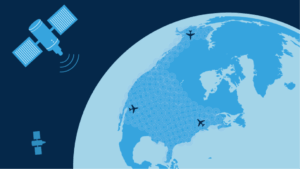Latest News
[Via Satellite 07-13-2016] Airbus and Boeing both released their 20-year global market forecasts on the first day of the 2016 Farnborough International Airshow. Airbus was less optimistic in it’s long term view of global demand for passenger jets, predicting airlines will require 33,000 new aircraft worth $5.2 trillion in the next two decades, while Boeing increased it’s 2016 outlook by 4.1 percent compared to 2015 predictions, projecting a global demand for 39,620 aircraft worth $5.9 trillion. While the two airframers’ expectations over the next 20 years differ, both forecasts — combined with recent moves by Airbus and Boeing as well as activity on the first day of Farnborough — shows that a significant number of the aircraft delivered between now and 2035 will feature advanced forms of cockpit and cabin-based satellite-powered broadband connectivity.
The average between the figures released by the two Original Equipment Manufacturers (OEMs) is equal to a 20-year demand for 36,310 aircraft worth $5.5 trillion. Both companies also expect the global in-service fleet to double from today’s nearly 20,000 to 40,000 new aircraft or more by 2035.
Among the most important details in both reports regarding satellite-based broadband is a shared view that the largest demand for new jets will continue to be single-aisle airliners such as the re-engined A320neo and 737 MAX. Boeing specifically expects low-cost carriers within emerging markets to drive growth for single-aisle aircraft, which it estimates will lead to demand for 28,140 new airplanes. Aircraft of this size already account for 76 percent of Boeing’s current global order backlog.
Similarly, Airbus forecasts demand for 23,500 new single-aisle aircraft or 71 percent of expected deliveries over the next 20 years. The A320 will account for the largest number of deliveries over the next two decades within this segment. The company appears to be gearing up for the increased use of satellite powered Internet Protocol (IP) for both cabin and cockpit through a recent agreement with Cobham Satcom. At the end of June, Airbus selected Inmarsat’s SwiftBroadband-Safety (SB-S) service available from Cobham Satcom’s Aviator S series terminals, as future equipment for its A320 and A330 families. Under Cobham’s contract with Airbus, the company will begin to install hardware on the two aircraft families starting in 2018, well within the 20-year outlook.
However, Inmarsat and Cobham aren’t the only viable players in satellite-powered IP for this demand period. Flyht Aerospace continues to evolve and prove the capabilities and values provided by its’ Iridium-powered Automated Flight Information Reporting System (AFIRS).
On the passenger side, Gogo’s 2Ku service will prove its capabilities within the first few years of the Airbus and Boeing 20-year forecast periods, based on recent contracts to add the technology to 137 International Airlines Group (IAG) aircraft, and it will also start flying on 35 Delta Airlines jets this year. That number will be increasing to a total of 600 Delta jets based on an agreement announced between the two companies in May.
Get the latest Via Satellite news!
Subscribe Now